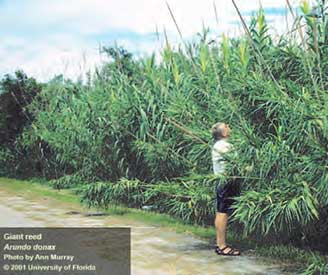Giant Reed
Arundo donax
Description
Tall, perennial grass that can grow to over 20 ft. in height. Its fleshy, creeping rootstocks form compact masses from which tough, fibrous roots emerge that penetrate deeply into the soil. Leaves are elongate, 1 – 2 in. wide and a foot long. The flowers are borne in 2ft. long, dense, plume-like panicles during August and September.
Habitat
Becomes established in moist places such as ditches, streams, and riverbanks, growing best in well
drained soils where abundant moisture is available. It tolerates a wide variety of conditions, including high salinity, and can flourish in many soil types from heavy clays to loose sands.
Location in Nebraska
Few isolated locations in Lancaster County.
Pathway of Introduction and Spread
Reproduction of giant reed is primarily vegetative, through rhizomes which root and sprout readily. Can float miles downstream where root and stem fragments may take root and initiate new infestations. Can also be spread when attached to boats and other aquatic equipment.
Impacts
Chokes rivers and streams, crowds out native plants, interferes with flood control, increases fire potential, and reduces habitat for wildlife. Root mats form dams behind bridges, culverts, and other structures.
Ann Murray, University of Florida

